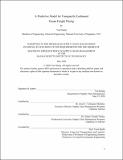| dc.description.abstract | The containerized ocean freight market has been very volatile due to overcapacity and several disruptive changes. As a global ocean freight forwarder, C.H. Robinson hopes to improve the predictability of the spot ocean freight rates, especially on the Transpacific Eastbound (TPEB) lanes which represent its largest trade volumes. Therefore, this research aims to build a predictive model for the TPEB spot freight rates using publicly available economic indicators and carrier data sources. Two predictive models corresponding to the US East Coast (USEC) routes and the US West Coast (USWC) routes are developed. The models for the China-origin routes are able to capture 69.0% of the variances in the USEC spot rates and 55.4% of the variances in the USWC spot rates. As an initial exploration, this research identifies 6 sets of critical economic indicators and unveils their effects on the TPEB spot rates. It also highlights the impact of 3 disruptive events and points out a few promising directions for future study on the ocean freight dynamics. | en_US |
